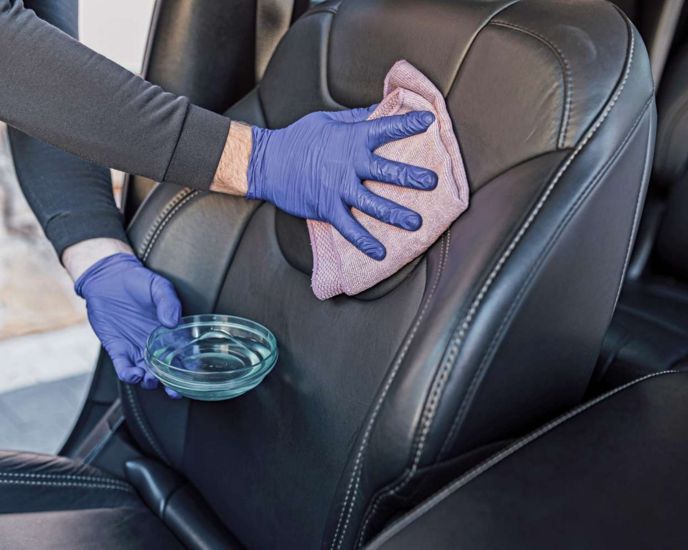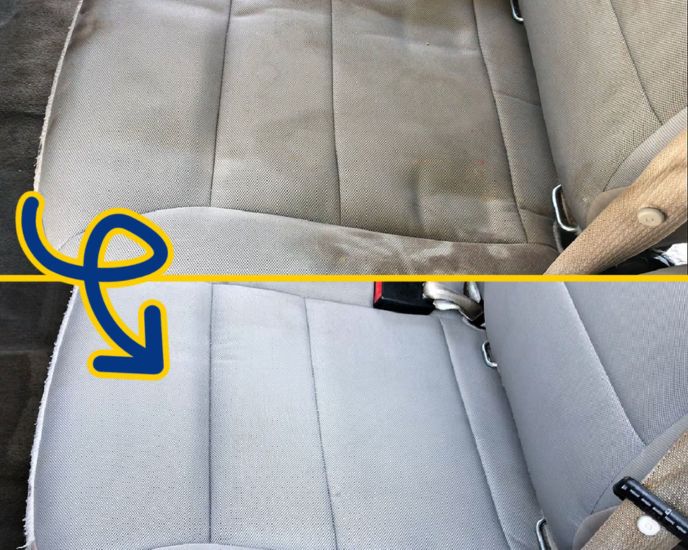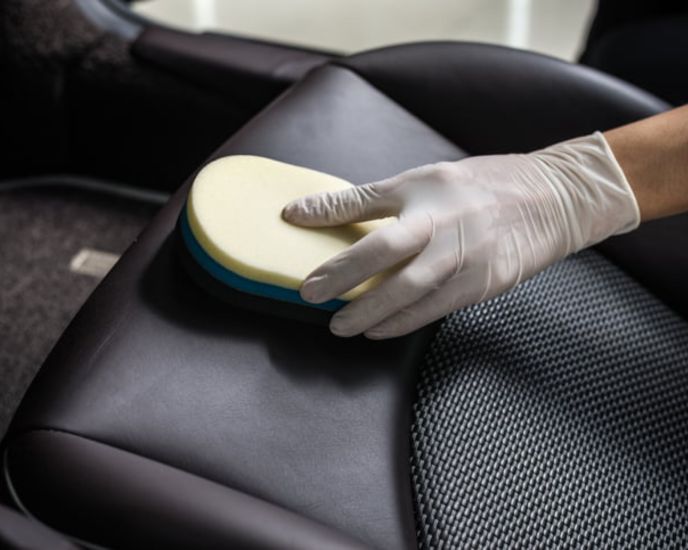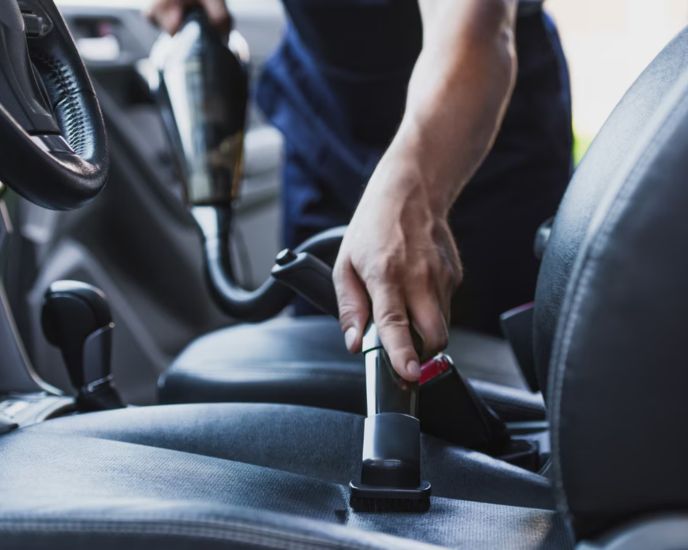Leather car seats bring a touch of luxury and comfort to any vehicle, making every drive feel more sophisticated and enjoyable. However, just like any high-quality material, leather needs special care to keep its beauty and durability intact.

Without proper cleaning and maintenance, leather can lose its color and softness over time. This guide on How to Clean Leather Car Seats will take you through the essential steps to clean and care for your seats, ensuring they stay looking fresh, feel plush, and last for years to come.
Necessary Cleaning Supplies
Before you begin the cleaning process, gathering the right supplies is essential. Here’s what you’ll need:

Vacuum Cleaner with Brush Attachment: To remove dirt and debris from cracks and crevices.
Mild pH-Neutral Soap: Specific for leather to avoid damaging its surface.
Microfiber Cloths: Soft and effective for cleaning without scratching the leather.
Soft Bristle Brush: For stubborn stains.
Leather Conditioner: To keep the leather soft and prevent cracking.
How to Clean Leather Car Seats – Step-by-Step Cleaning Guide
To clean your leather car seats follow the steps given below:

- Vacuuming the Seats:
Start by thoroughly vacuuming the seats using the brush attachment. Pay special attention to the seams and crevices where particles tend to accumulate. Removing surface debris is crucial to prevent scratching the leather during the wet cleaning. - Preparing the Cleaning Solution:
Mix a few drops of mild pH-neutral soap with warm water in a bucket. Stir until you see bubbles. Why pH-neutral? Leather is sensitive to pH levels, and using a non-neutral cleaner could cause discoloration or drying. - Wiping Down the Seats:
Dampen a microfiber cloth in the soapy water, wring it out well, and gently wipe the leather surfaces. It’s important not to saturate the leather with water—leather should never be overly wet. Clean the seats in sections, frequently rinsing and wringing out the cloth to avoid spreading dirt. - Scrubbing Tough Stains:
Use a soft bristle brush for any stubborn stains that don’t come off with gentle wiping. Lightly dip it in your cleaning solution and gently scrub the paint in a circular motion. Be cautious not to press too hard, as this could damage the leather’s surface. - Drying and Conditioning:
Once the seats are clean, immediately dry them with a clean microfiber cloth to prevent water spots. After the seats are completely dry, apply a leather conditioner. This step is crucial as it replenishes the natural oils in the leather, preventing it from drying out and cracking. Apply the conditioner as directed on the package, using a clean cloth and buffing it into the leather in circular motions.
Regular Maintenance Tips
To keep your leather seats in top condition, clean them regularly, about once every three months, or more frequently if they get dirty sooner.

Quick wipes with a dry or slightly damp microfiber cloth can remove dust and prevent buildup for daily or weekly maintenance.
Troubleshooting Common Issues with Leather Car Seats
Even with regular care, leather car seats can face certain challenges over time. Here are some common issues and tips for troubleshooting them:

- Discoloration: Leather can lose its color due to exposure to sunlight, sweat, or other environmental factors. To address this, try using a leather conditioner or cleaner designed for color restoration. If discoloration persists, it may be necessary to consult a professional who can restore the leather’s original shade.
- Excessive Dryness: Leather can become dry and stiff, especially if it’s not properly conditioned. If your leather seats feel rough or dry, apply a high-quality leather conditioner to nourish the material and restore its softness. Regular conditioning helps maintain flexibility and prevents cracking.
- Cracks and Tears: Over time, leather can crack or tear due to wear and tear, exposure to heat, or lack of moisture. If the damage is minor, you can use a leather repair kit to patch small cracks. For more significant damage, it’s best to seek professional restoration services, as these repairs often require specialized techniques.
- Stubborn Stains: Spills and stains can be tough to remove, but it’s important to address them quickly. For most stains, a gentle mix of soap and water can help. For tougher stains, consider using a leather-specific cleaner. Avoid harsh chemicals that could damage the leather further.
- Fading: Leather can fade if exposed to the sun for extended periods. To prevent this, use sunshades or seat covers to protect your seats when the car is parked. If fading does occur, a professional leather dye might be necessary to restore the original color.
FAQ | How to Clean Leather Car Seats
Q.1 What is the best thing to clean leather car seats?
The best way to clean leather car seats is by using a leather cleaner or a gentle, mild soap mixed with water. Make sure to wipe it with a soft cloth to avoid scratching the surface.
Q.2 How do you make leather car seats look new?
To make leather car seats look new, clean them regularly with a leather cleaner, then apply a leather conditioner to keep them soft and shiny. This helps restore their original look.
Q.3 What is the best thing to clean leather with?
The best thing to clean leather with is a soft cloth and a leather cleaner or a mix of mild soap and water. Avoid using harsh chemicals, as they can damage the leather.
Q.4 What is the best car leather cleaner?
The best car leather cleaner is one that’s specially made for leather, like a pH-balanced cleaner. Look for one that cleans and conditions at the same time to keep your seats soft.
Q.5 Is it OK to clean leather with soap and water?
Yes, it’s OK to clean leather with mild soap and water, but you should always use a soft cloth and avoid soaking the leather. Be sure to dry it properly afterward.
Q.6 What is the best liquid to clean leather?
The best liquid to clean leather is a leather cleaner specifically designed for the material. If you don’t have one, you can use a mixture of water and mild soap for light cleaning.
Q.7 Is baking soda safe for leather?
Baking soda is generally safe for leather in small amounts. It can be used to remove odors, but avoid scrubbing too hard, as it can dry out the leather.
Q.8 What is the best homemade leather conditioner?
A simple homemade leather conditioner can be made with equal parts of olive oil and vinegar. Apply it gently with a soft cloth, and wipe away any excess to keep the leather soft and moisturized.
Q.9 What is the best cleaner for leather car seats?
The best leather seat cleaner is a mild, pH-neutral soap diluted in water. Avoid harsh chemicals such as bleach or ammonia-based cleaners, as they can damage the leather. Products specifically designed for leather care are recommended because they clean effectively without risking damage to the material.
Conclusion | How to Clean Leather Car Seats
Cleaning your leather car seats not only enhances your vehicle’s appearance but also helps maintain the material’s durability and comfort. By following these simple steps, you can ensure your leather seats stay vibrant, soft, and luxurious, providing both style and comfort for years to come.

Have you tried any of these methods, or do you have your own tips for keeping leather car seats in top condition? Share your experiences in the comments below. For more car care tips and tricks, don’t forget to subscribe to our newsletter and stay tuned for more helpful advice!
Also Read : How to Clean Leather Couch? | The Ultimate Guide

